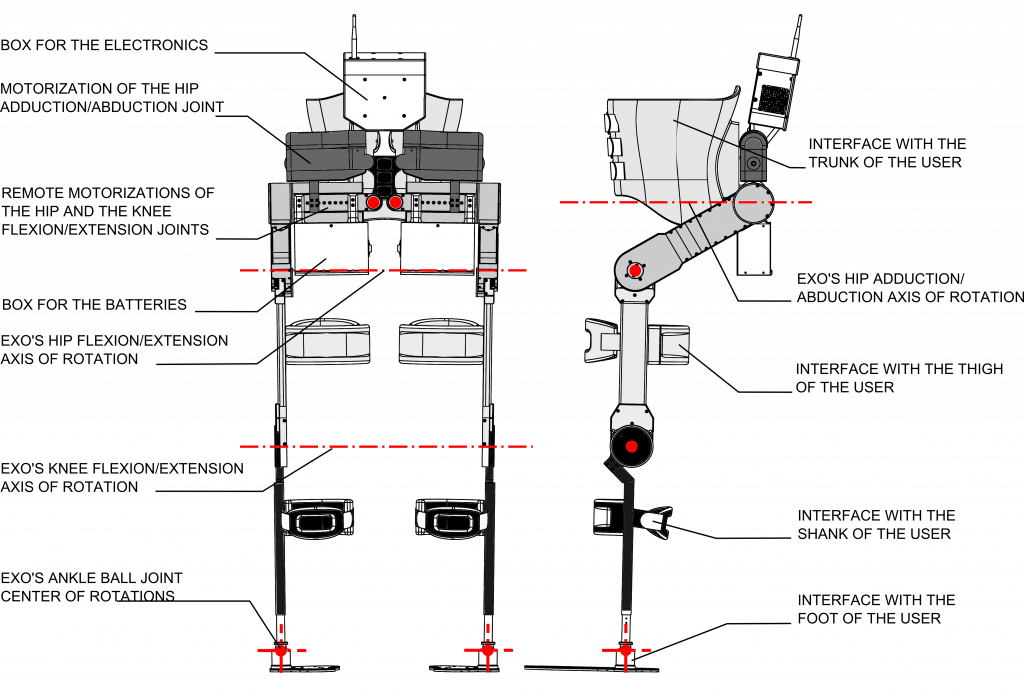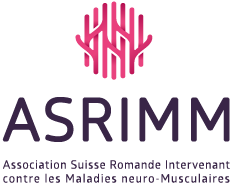AUTONOMYO is a lower limb exoskeleton designed to assist walking for people with muscular weakness or motor deficits
About the project
The project AUTONOMYO was initiated by a Swiss association against neuromuscular diseases called ASRIMM. It is currently also supported by the Swiss Foundation for the Research on Neuromuscular Diseases FSRMM and the Swiss Multiple Sclerosis Society. The REHAssist group works jointly with the CHUV to evaluate the safety and the benefits of such devices for persons with different type of disorders in clinical environment. Finally, industrial partners such as Faulhaber GmbH support the project to embed innovative actuation technologies.
Research topics
From the mechanical design to the control strategy, several challenging research topics are tackled:
- Design of a highly transparent multiple actuation system reproducing all user’s degrees of freedom
- Haptic human-robot interaction acting in accordance with the intention of the user
- Adjustable assistance to assist the user as needed
- Balance augmentation strategy to prevent the user from falling
- Compact, lightweight and aesthetic mechanical structure for improving the user experience
Design specifications
The exoskeleton includes three actuated degrees of freedom per leg, corresponding to the human hip adduction/abduction, the hip flexion/extension and the knee flexion/extension motions. All joints are driven by brushless motors. The flexion/extension actuators are remotely located from the joints using a wire-cable transmission in series with planetary gears. The abduction/adduction actuation is transmitted through a 4-bar linkage and a ball-screw system. About the ankle, the exoskeleton includes a passive ball joint. The exoskeleton weights about 25kg and is fastened to the user through orthopaedic interfaces located at the trunk, the shanks and the feet.

Related publications
- Ortlieb, A., Lichard, P., Dzeladini, F., Baud, R., Bleuler, H., Ijspeert, A., Bouri, M., 2019. Investigation on Variable Impedance Control for Modulating Assistance in Walking Strategies with the AUTONOMYO Exoskeleton, in: Carrozza, M.C., Micera, S., Pons, J.L. (Eds.), Wearable Robotics: Challenges and Trends, Biosystems & Biorobotics. Springer International Publishing, pp. 75–79.
- Ortlieb, A., Baud, R., Tracchia, T., Denkinger, B., Herzig, Q., Bleuler, H., Bouri, M., 2018. An Active Impedance Controller to Assist Gait in People with Neuromuscular Diseases: Implementation to the Hip Joint of the AUTONOMYO Exoskeleton. 2018 7th IEEE International Conference on Biomedical Robotics and Biomechatronics (Biorob) 537–543.
- Ortlieb, A., Bouri, M., Baud, R., Bleuler, H., 2017. An assistive lower limb exoskeleton for people with neurological gait disorders, in: 2017 International Conference on Rehabilitation Robotics (ICORR). Presented at the 2017 International Conference on Rehabilitation Robotics (ICORR), pp. 441–446.
- Ortlieb, A., Olivier, J., Bouri, M., Bleuler, H., Kuntzer, T., 2015. From gait measurements to design of assistive orthoses for people with neuromuscular diseases, in: 2015 IEEE International Conference on Rehabilitation Robotics (ICORR). Presented at the 2015 IEEE International Conference on Rehabilitation Robotics (ICORR), pp. 368–373.
Contact
More information can be found on the project website.
Contact: Dr Amalric Ortlieb
Partners of the project
| Faulhaber | ASRIMM | FSRMM | CHUV | Swiss MS Society |
|
|
 |
|
|